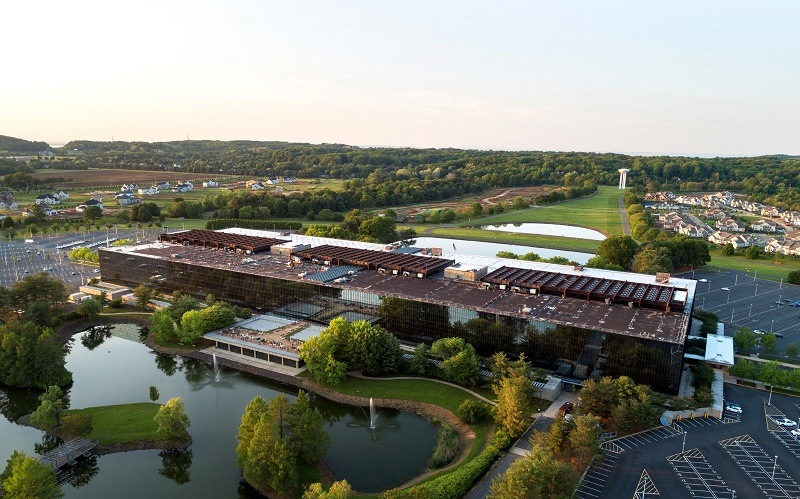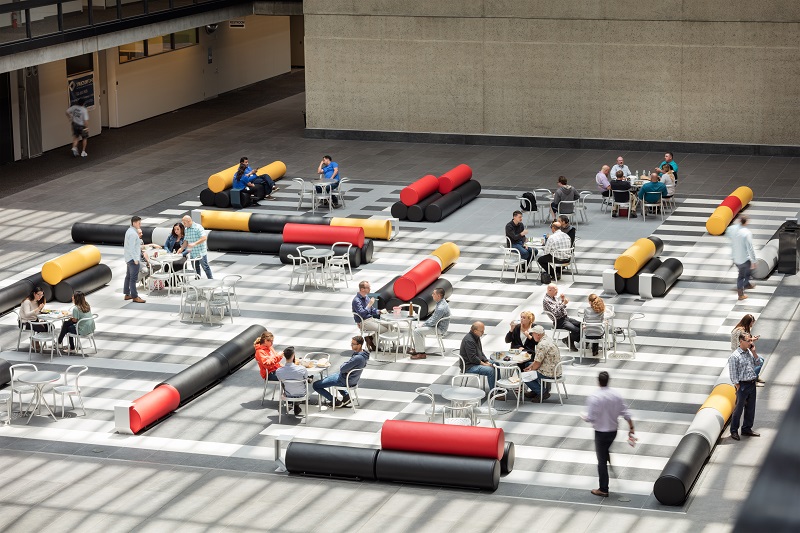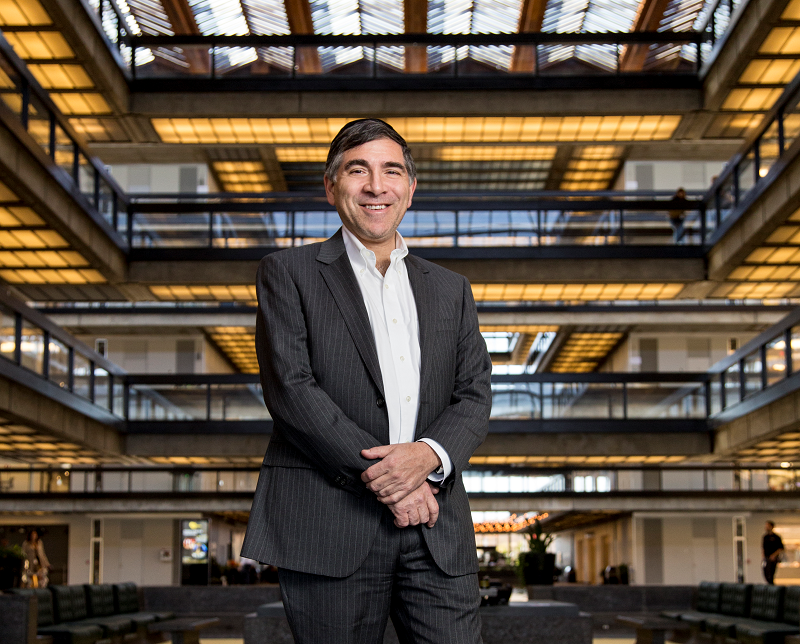Ralph Zucker, president of Somerset Development, at Bell Works in Holmdel — Courtesy: Somerset Development
By Joshua Burd
Bell Works was firing on all eight cylinders.
That’s how Ralph Zucker described it as he thought back to early March, when the 2 million-square-foot building in Holmdel was teeming with thousands of office workers and patrons of its shops, restaurants and entertainment venues. The property was also hosting regular events, including a planned March Madness basketball tournament that would be complete with three dozen teams, printed T-shirts and a regulation-size court inside the west atrium.
Then came the coronavirus, which suddenly threatened everything Somerset Development had done to reposition and repopulate the iconic Bell Labs complex over more than a decade.
“Everything we set out to do from 2008 — we were there,” said Zucker, Somerset Development’s president. “And within three days we had to turn everything off.”
As Zucker explained, the process of shutting down Bell Works would actually take about two weeks. But it was almost immediately clear that, for a property that thrives on people congregating indoors, the COVID-19 crisis had upended one of New Jersey’s most complex, creative and high-profile adaptive reuse projects as it was nearing the peak of its success.
Somerset has navigated the crisis much in the same way it did as it breathed new life into the shuttered landmark: with patience, optimism and a relentless ambition to find solutions. The firm has also remained community-minded and focused on inclusiveness, from feeding frontline workers to maintaining communication with its office and retail tenants.
It’s why Zucker is confident that the building will return to form as a hub for the region.
“I walked in here in 2008 to a vacant building and spent all those years and all that effort to repopulate it,” he said. “And I walked in recently and the building felt just vacant — the only difference is that now it’s pristine, it’s beautiful, it’s in great shape.
“And, whereas in 2008, people wrote Bell Labs off, today there are thousands and thousands of people, both tenants and people in the community, that are just yearning to get back inside Bell Works.”

As Zucker noted, the process of closing down Bell Works effectively began March 10, the day after Gov. Phil Murphy declared a public health emergency in New Jersey. That was when the tech company iCIMS, the building’s largest tenant, pulled its employees from the complex and directed them to work from home.
“That was the first major company at Bell Works to do so,” Zucker said, as other tenants and retailers followed suit. The management team also began to weigh if and when it should close the building to the general public, despite strong bookings for operators such Escapology and Swing Loose, an escape room and indoor virtual golf facility, respectively.
“As companies started leaving … we felt that, as people were trying to social distance and do the right thing, it wasn’t the right thing for us to bring people in.”
Bell Works officially went dark on March 21, when Murphy took the crucial step of ordering millions of state residents to stay home and closing all non-essential businesses. But the property faced another challenge in early April — about two weeks after Murphy had closed state and county parks — as area residents were congregating and tailgating in its sprawling parking lots.
Zucker’s team, seeking to be “in lockstep” with state and local officials, on April 18 closed the grounds to non-tenants, although still allowing joggers and bicyclists to pass through the site.
“It’s been a slow and steady decline,” Zucker said in an interview in late April, as he visited the property for just the second time since the lockdown began. He estimated at the time that there were about two dozen people from essential businesses in the building, a far cry from when it hosted 4,000 daily office workers and hundreds of other visitors.
Still, Bell Works has managed to play an important role during the crisis, in part by leveraging the vast network that has developed within the building. Zucker and his firm donated a combined $22,000 to kick off a campaign known as Not All Heroes Wear Capes, which went on to raise another $40,000 from March 31 through May 2. The effort allowed Bell Market, the building’s on-site lunch spot, to provide more than 500 meals daily to frontline workers at Bayshore Medical Center, the PNC Bank Arts Center testing site and other area locations.
The property has served the community in other ways. Zucker noted that Bell Works’ weekly farmer’s market, which had grown to more than 100 vendors pre-COVID, has shifted to a curbside pickup and delivery model in which about a dozen businesses sell boxes of food and fresh produce, providing local residents with an alternative to the supermarket.

Other retailers at the complex have tried to weather the storm with delivery and e-commerce, although neither is an option for tenants such as Salon Concrete or Dimension Dental Care. Somerset Development has been flexible with many of those tenants when it comes to their rent obligations, Zucker said, given that they were forced to close.
The firm has also been working on a plan to help rebuild the thriving, indoor concourse known as The Block at Bell Works that would allow operators “to reopen when allowed and grow back into their business.”
“We worked very hard to craft a Main Street here and we have a great group of retailers,” Zucker said. “Most of them are mom-and-pop shops and local. Some of them invested their life savings, whether it’s a small restaurant or whatever the use is, and we are going to do our best to allow them to grow back slowly as the market opens up again.”
Zucker thinks those tenants, especially restaurants, are “in a great position” because of the space afforded by Bell Works’ 120,000-square-foot atrium. He pointed to how eateries have adapted in Europe, where patrons can enter the business to pick up their food and then dine outside at tables that are separated by several feet.
To that end, Somerset is planning to buy hundreds of small café tables, along with plants that will provide a natural social distance between diners, he said. The property will also have cleaning crews at the ready to sanitize tables after each use.
“We’re adapting on the retail end,” Zucker said, while bringing office tenants back is another conversation altogether. He noted that his team has had weekly Zoom calls with its major tenants and has been working on a set of best practices for helping them return to work.
The veteran developer knows that, whenever the state allows non-essential office workers to return, it will be at a reduced capacity and that individual strategies will vary by company.
“We’re definitely hearing from a lot of our tenants that they need to spread out,” Zucker said. “Some of them have cubicles and it’s a little bit easier. Some of have them more benching- or hoteling-type of spaces and they may have people alternate days or they may have every other desk unoccupied.”
In the meantime, Bell Works is crafting a social distancing program that will include signage and wayfinding to create one-way traffic in the atrium and in stairwells and to limit large groups in elevators. The team is also refining its plans for cycling in fresh air, upgrading filtration and implementing “much more intense cleaning in the office and common spaces.”
“We have the benefit of having a lot of space, we have the benefit of having a great team,” Zucker said. “We were never just a landlord — we were much more a landlord that’s also in the hospitality business, so we’re set up in that way. We have our concierge-level service and our own in-house ability to market and design and implement, so we know we’re going to be on the cutting edge of repopulating the space.”
Not only does Bell Works have an abundance of space, but space that is spread across a vast horizontal footprint that stretches a quarter-mile from end to end. The building is only six stories tall, allowing it to avoid the pitfalls that urban high-rises will face in the months ahead.
“Having to take two people in an elevator when you’ve got to get to the 60th floor, and there’s really no option to take the stairs, is not great,” Zucker said. “So in a way we’re very fortunate that, although we’re as big as or larger than the Empire State Building, you only have to walk up at most five flights, so we’re definitely going to encourage people to be using the stairs.”










